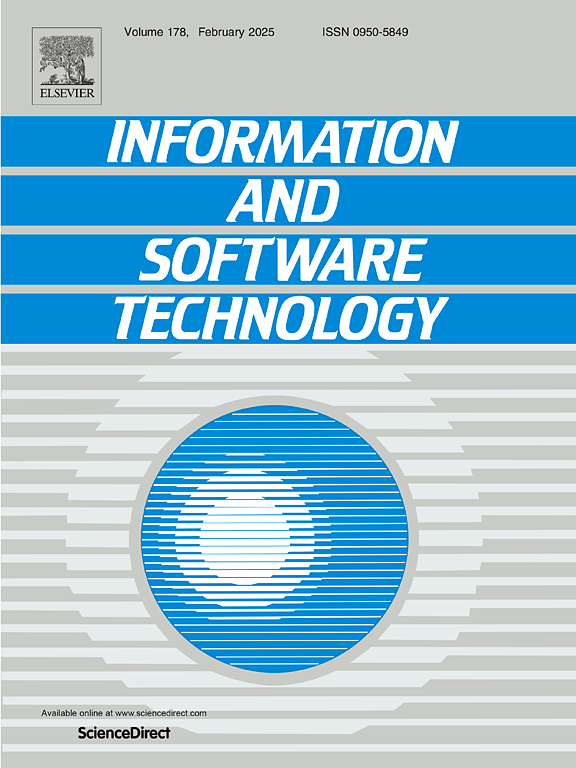Constructing the graphical structure of expert-based Bayesian networks in the context of software engineering: A systematic mapping study
IF 3.8
2区 计算机科学
Q2 COMPUTER SCIENCE, INFORMATION SYSTEMS
引用次数: 0
Abstract
Context:
In scenarios where data availability issues hinder the applications of statistical causal modeling in software engineering (SE), Bayesian networks (BNs) have been widely used due to their flexibility in incorporating expert knowledge. However, the general understanding of how the graphical structure, i.e., the directed acyclic graph (DAG), of these models is built from domain experts is still insufficient.
Objective:
This study aims to characterize the SE landscape of constructing the graphical structure of BNs, including their potential for causal modeling.
Method:
We conducted a systematic mapping study employing a hybrid search strategy that combines a database search with parallel backward and forward snowballing.
Results:
Our mapping included a total of 106 studies. Different methods are commonly combined to construct expert-based BN structures. These methods span across data gathering & analysis (e.g., interviews, focus groups, literature research, grounded theory, and statistical analysis) and reasoning mechanisms (e.g., using idioms combined with the adoption of lifecycle models, risk-centric modeling, and other frameworks to guide BN construction). We found a lack of consensus regarding validation procedures, particularly critical when modeling cause–effect relationships from knowledge. Additionally, expert-based BNs are mainly applied at the tactical level to address problems related to software engineering management and software quality. Challenges in creating expert-based structures include validation procedures, experts’ availability, expertise level, and structure complexity handling. Key recommendations involve empirical validation, participatory involvement, and balance between adaptation to organizational constraints and model construction requirements.
Conclusion:
The construction of expert-based BN structures in SE varies in rigor, with some methods being systematic while others appear ad hoc. To enhance BN application, reducing expert knowledge subjectivity, enhancing methodological rigor, and clearly articulating the construction rationale is essential. Addressing these challenges is crucial for improving the reliability of causal inferences drawn from these models, ultimately leading to better-informed decisions in SE practices.
在软件工程背景下构建基于专家的贝叶斯网络图形结构:系统映射研究
背景:在软件工程(SE)中,数据可用性问题阻碍了统计因果建模的应用,在这种情况下,贝叶斯网络(BN)因其结合专家知识的灵活性而被广泛使用。本研究旨在描述构建贝叶斯网络(BNs)图形结构的 SE 情况,包括其在因果建模方面的潜力。方法:我们采用混合搜索策略进行了系统的映射研究,该策略结合了数据库搜索和平行的前向和后向滚雪球搜索。我们通常采用不同的方法来构建基于专家的 BN 结构。这些方法涉及数据收集&;分析(如访谈、焦点小组、文献研究、基础理论和统计分析)和推理机制(如使用惯用语结合生命周期模型、以风险为中心的建模和其他框架来指导 BN 构建)。我们发现在验证程序方面缺乏共识,尤其是在对知识的因果关系建模时,这一点尤为重要。此外,基于专家的 BN 主要应用于战术层面,以解决与软件工程管理和软件质量相关的问题。创建基于专家的结构所面临的挑战包括验证程序、专家的可用性、专业知识水平和结构复杂性处理。主要建议包括经验验证、参与式参与,以及在适应组织约束和模型构建要求之间取得平衡。要加强生物网络的应用,必须减少专家知识的主观性,提高方法的严谨性,并明确阐述构建的理由。应对这些挑战对于提高从这些模型中得出的因果推论的可靠性至关重要,最终可在 SE 实践中做出更明智的决策。
本文章由计算机程序翻译,如有差异,请以英文原文为准。
求助全文
约1分钟内获得全文
求助全文
来源期刊

Information and Software Technology
工程技术-计算机:软件工程
CiteScore
9.10
自引率
7.70%
发文量
164
审稿时长
9.6 weeks
期刊介绍:
Information and Software Technology is the international archival journal focusing on research and experience that contributes to the improvement of software development practices. The journal''s scope includes methods and techniques to better engineer software and manage its development. Articles submitted for review should have a clear component of software engineering or address ways to improve the engineering and management of software development. Areas covered by the journal include:
• Software management, quality and metrics,
• Software processes,
• Software architecture, modelling, specification, design and programming
• Functional and non-functional software requirements
• Software testing and verification & validation
• Empirical studies of all aspects of engineering and managing software development
Short Communications is a new section dedicated to short papers addressing new ideas, controversial opinions, "Negative" results and much more. Read the Guide for authors for more information.
The journal encourages and welcomes submissions of systematic literature studies (reviews and maps) within the scope of the journal. Information and Software Technology is the premiere outlet for systematic literature studies in software engineering.
 求助内容:
求助内容: 应助结果提醒方式:
应助结果提醒方式:


